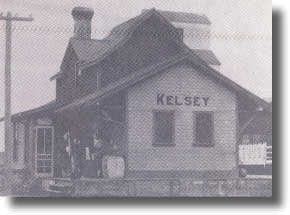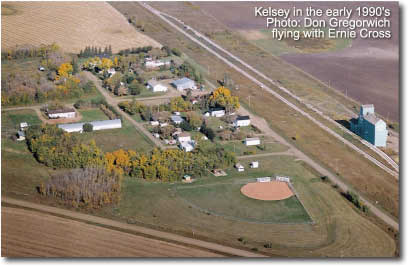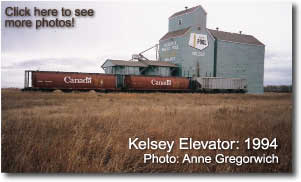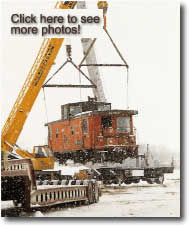Dave Davies hauled the first load of lumber to where the town of Kelsey was to be built. He could only find a stake in the ground, so he unloaded his lumber by the stake.
In 1915, the Canadian National Railway began laying steel in a south-easterly direction from Camrose. It passed through what a few weeks later became the town of Kelsey, and country which is now known as prime farm land.
One of the early settlers, Arnold Nelson, and his brothers, Norman and Ralph Nelson, built parts of the C.N.R. grades between Camrose and Alliance. One camp site was at Mile 10 which is west of Kelsey, and another was east of Kelsey at Cross's lake on the Ed and Bill Cross land. Their cook tent was set up and the horses were wintered there. This stretch of railroad is noted for being the longest stretch of straight railway in North America..."if not in the world", some people add. Charlie Cooper helped to lay the steel and was later made section foreman.
In 1916, a station house was built in Kelsey and Charlie Cooper, with his wife Anne and sons Fred, Sidney and Lance took up residence in it. They lived in the station house until 1918. Charlie was railway foreman until Fred Davignon came in 1939.
Some of the section hands who worked with him were Jim McDonald, Pete Runka, Joe Turback, Vertis Heron and Henry Lorenz. The old timers still remember a train wreck which took place between the water tank and Kelsey in 1916.
Jack Hawley was one of the conductors on the C.N.R. train that came through Kelsey. He was well known to many Kelsey folks. He had bought the quarter of land Moses Kelsey had homesteaded. His daughter, Ruth Smock and sons John, Leroy and Dick lived on the farm. They moved to California in 1935.
The North Star elevator was being built at the same time as the steel was being laid. It was only in operation about a year when it was destroyed by fire. Allen Chisholm was the agent at the time. It was rebuilt, and some years later it was named "Reliance." It was bought by the United Grain Growers.
Interesting Facts & Timeline
2005 Population:
Retail Business Establishments:
Landmarks:
- Old Kelsey Church...now the local Post Office
- Kelsey Community Hall...the home of community events
Timeline:
1902:
- Moses Kelsey Family arrives from Milbank, South Dakota
- Milton Zimmerman settles in the area
1915:
- Canadian National Railway began laying steel
1916:
- Kelsey becomes a town
- A station house was built

- Charlie Bowen builds a general store
- North Star elevator is built
- Fred MacDonald builds a store
today that site is the home of Kelsey Farm Equipment
1917:
- Telephone service was installed in the Kelsey district
1920:
- Kelsy Union Church is built
- Albert Zimlicka builds a modern dance hall
1923:
- Kelsey School was formed
- Hall purchased and made into a one room school
1929:
- Kelsey School becomes a two room school
1937:
- A skating rink was built across from the present hall
1938:

- Frank Baumle moved his garage to Kelsey
- Kelsey Hall building in progress
1939:
- Kelsey Hall opened, first dance Jan. 1, 1939
1950:
- The first power line reached the town of Kelsey
1951:
- A two sheet curling rink was built

1993:
- First Kelsey Dinner Theatre performance
1997:
- Alberta Wheat Pool elevator demolished

- The Canadian National caboose arrives in Kelsey

2001:
- First Summer Dinner Theatre
- Ball diamond illuminated